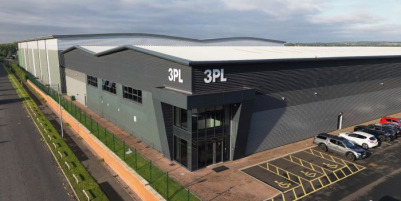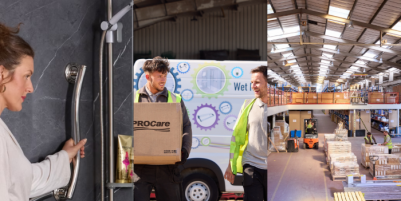-
LiftEx 2025 live from Liverpool - 13 hours ago
-
DATA ANALYSIS – THE FOUNDATION OF EVERY PEAK SEASON - December 5, 2025
-
Creative education specialists Creative Hut give 3PL full marks for onboarding excellence - December 5, 2025
-
Unlimited Industries raises $12M to build the AI construction company that will power America’s future - December 4, 2025
-
Scottish Leather Group gets full-support solution from Rushlift - December 4, 2025
-
Etaily lands strategic investment from Japan’s SMBC – bringing total funding to $24M for Social Commerce enablement platform - December 4, 2025
-
Winners lift their LEEA Awards and raise the industry - December 4, 2025
-
Prism eLogistics and Brand Angels Partnership Gives Brands the Full Package - December 3, 2025
-
New data shows Tesla in danger of losing its way as European consideration to buy Chinese cars jumps 16% in 12 months - December 3, 2025
-
QUECLINK DEVELOPS SATELLITE-ENABLED VEHICLE TRACKING FOR UNINTERRUPTED TRANSPORT MANAGEMENT - December 3, 2025
Land transportation across North, Central, and South America offers a mix of both challenges and opportunities for the logistics industry. Given the diverse landscapes and varying infrastructure capabilities, businesses need to be adept at managing transportation in this expansive region.
From the busy cities of North America to the vast terrains of Central and South America, it’s essential to understand local regulations and customs to facilitate smooth transportation.
Many businesses are already adopting solutions such as intermodal freight, cargo consolidation, and temporary warehousing to address these challenges, witnessing significant benefits in the process.
Unpacking the Land Transport Landscape in the Americas
The transportation systems within the Americas are incredibly varied, reflecting the unique nature of each region. North America boasts sophisticated road systems, while Central and South America continually develop and refine their infrastructure. These transportation systems are vital for transporting goods, people, and services throughout these areas.
North America
The predominant feature of North America’s transportation landscape is its vast highways and railways that weave across the area. The United States, Canada, and Mexico primarily depend on trucking for their domestic freight needs.
Notably, the railway system is a key player in long-distance freight transport, with companies like Union Pacific and BNSF in the U.S., Canadian National Railway and Canadian Pacific in Canada, and Ferromex in Mexico at the forefront.
Central and South America
Central and South America offer a more varied scenario. While road transportation is the mainstay, the quality and range of road systems differ significantly. Nations such as Brazil and Argentina showcase more mature transportation infrastructures, while others are navigating the complexities of development. Although rail is not as widespread, there are ongoing initiatives to enhance and broaden these networks.
Prominent transport companies in this zone are JSL in Brazil and DB Schenker in Argentina. Additionally, the expansion of the Panama Canal has introduced fresh avenues for integrated sea and land transportation.
Key Challenges in Land Transport across North, Central, and South America
While pivotal for economic growth and connectivity, land transport in the Americas faces several challenges that can hinder efficiency and progress. These challenges span across infrastructure, regulations, and even the implementation of sustainable logistics solutions.
Infrastructure
Across the board, infrastructure remains a significant concern. In North America, there’s a growing urgency to address the deteriorating state of existing structures. For instance, the 2021 report from the American Society of Civil Engineers handed the U.S. infrastructure a “C-” grade, underscoring the pressing need for upgrades. Worn-out roads, bridges, and railways hinder transportation efficiency and raise costs and safety issues.
On the other hand, Central and South America face issues from outdated and insufficient infrastructure. Many remote locations are isolated due to limited road and rail connectivity. This gap hampers the potential and effectiveness of overland transportation in these regions.
Regulations
Regulatory challenges also pose significant hurdles. Inconsistent regulations across different countries can complicate cross-border transportation.
For instance, trucking regulations vary from country to country in terms of load limits, driver hours, and vehicle standards. This inconsistency can create confusion and inefficiency, making it difficult for logistics providers to plan and execute seamless transport operations.
How are Organizations Addressing Recent Challenges?
Organizations are turning to innovative solutions to streamline their operations and improve freight efficiency. These strategies include embracing 4PL logistics, leveraging short-term warehousing, and relying on intermodal freight solutions.
The Concept of 4PL Logistics
Fourth-party logistics, or 4PL, refers to a supply chain model where businesses outsource both the management and execution of their entire logistics operations to a single partner. This partner, the 4PL provider, oversees all aspects of the supply chain, from procurement and transport to warehousing and distribution.
4PL providers can bring significant benefits to businesses operating in the Americas. They can simplify complex logistics processes and provide better visibility across the supply chain by offering a single point of contact and responsibility.
Furthermore, their expertise and networks can help navigate the region’s diverse regulatory and infrastructural challenges of land transport.
The Role of Short-Term Warehousing in Land Transport
Short-term warehousing involves renting warehouse space for a limited period, offering businesses flexibility to respond to seasonal demand fluctuations or unexpected events. It allows companies to store goods closer to customers, reducing transport times and costs.
In the context of land transport across the Americas, short-term warehousing can help overcome some of the infrastructural challenges. Businesses can bypass regions with poor infrastructure by strategically locating warehouses in areas with better road or rail connections, enhancing their ability to deliver goods efficiently.
Reliance on Intermodal Freight Solutions
Intermodal freight involves transporting goods using two or more modes of transportation – such as truck, rail, or ship – without handling the freight itself when changing modes. The process is facilitated by using containers easily transferred between different transport modes.
Intermodal freight offers a potential solution to improve land transport in the Americas. By combining different modes of transport, businesses can leverage the strengths of each mode and avoid areas with infrastructural challenges. For example, goods could be transported by rail or ship to regions with good infrastructure, then transferred to trucks for final delivery.
Keeping an Eye on Future Trends in Land Transport
As we look ahead, the land transport landscape in North, Central, and South America is poised to undergo significant transformations. Current trends suggest a continued push toward more integrated and efficient logistics solutions driven by the evolving needs of businesses and consumers.
The role of 4PL logistics, short-term warehousing, and intermodal freight will be pivotal in shaping this future. As organizations seek more streamlined, flexible, and cost-effective ways to manage their supply chains, these solutions will likely gain even greater prominence.
While challenges in land transport persist, the future holds considerable potential for innovation and growth.
By keeping an eye on these emerging trends and embracing innovative solutions like 4PL logistics, short-term warehousing, and intermodal freight, businesses can equip themselves to navigate this dynamic landscape and drive success in the years to come.
Author Bio:
Joe Jaska
Joe Jaska is the Head of Land Product for Region Americas at DB Schenker, a role he has held since early 2020. He has full P&L responsibilities for 24 countries in North, Central, and South America, leading land transport to ensure quick and reliable delivery to all major destinations across the continent. Joe ensures full or partial truckloads move across the continent or across borders without delay.

































